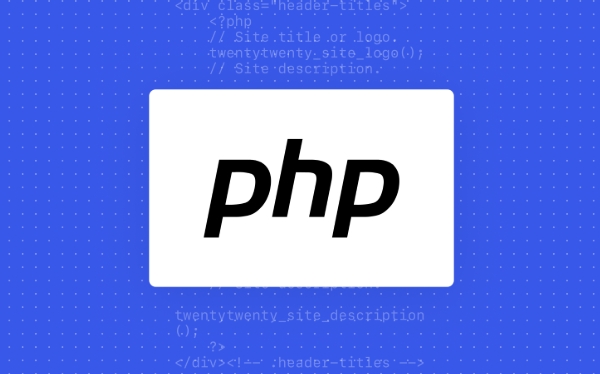A Deep Dive into PHP's Internal Garbage Collection Mechanism
Jul 28, 2025 am 04:44 AMPHP's garbage collection mechanism is based on reference counting, but circular references need to be processed by a periodic circular garbage collector; 1. Reference count releases memory immediately when there is no reference to the variable; 2. Reference reference causes memory to be unable to be automatically released, and it depends on GC to detect and clean; 3. GC is triggered when the "possible root" zval reaches the threshold or manually calls gc_collect_cycles(); 4. Long-term running PHP applications should monitor gc_status() and call gc_collect_cycles() in time to avoid memory leakage; 5. Best practices include avoiding circular references, using gc_disable() to optimize performance key areas, and dereference objects through the ORM's clear() method, and ultimately ensuring efficient memory management to cope with complex scenarios.

PHP's garbage collection (GC) mechanism is often overlooked by developers who assume that, as a high-level scripting language, memory management is entirely abstracted away. While PHP does handle most memory cleanup automatically through reference counting, understanding its internal garbage collection process—especially how it deals with circular references and resource cleanup—can help optimize performance and avoid memory leaks in long-running scripts or complex applications.

Let's take a deep dive into how PHP manages memory and garbage collection under the hood.
How PHP Managements Memory: Reference Counting
At its core, PHP uses reference counting as the primary method for tracking and managing memory. Every variable in PHP is represented internally as a zval (Zend value), which holds the value and metadata like type and reference count.

Each time a variable is assigned or passed around, the reference count of its zval increases. When a variable goes out of scope or is unset, the reference count decreases. Once the count reaches zero, PHP immediately frees the associated memory.
For example:

$a = "hello"; $b = $a; // refcount becomes 2 unset($a); // refcount drops to 1 unset($b); // refcount drops to 0 → memory freed
This system is efficient and determine—memory is freed as soon as it's no longer needed, except when circular references are involved.
The Problem: Circular References
Reference counting fails when circular references occur—when two or more objects refer to each other, creating a cycle that keeps their reference counts above zero, even when they're no longer accessible from the root of the application.
Example:
class Node {
public $parent;
}
$a = new Node();
$b = new Node();
$a->parent = $b;
$b->parent = $a;
unset($a, $b); // refcount doesn't reach zero due to cycle Even though $a and $b are unset, each still holds a reference to the other, so their zval s never get cleaned up. This creates a memory leak .
This is where PHP's cyclic garbage collector comes in.
PHP's Cyclic Garbage Collector
To solve this, PHP implements a cyclic garbage collector that runs periodically to detect and clean up circular references. It was introduced in PHP 5.3 and works alongside reference counting.
How It Works
The GC doesn't run on every unset() or scope exit. Instead, it triggers under specific conditions:
- When the number of "possible root" zvals reach a threshold (default: 10,000).
- Or manually triggered via
gc_collect_cycles().
A "possible root" is a zval with a reference count > 0 that might be part of a cycle. When such objects are detected, they're added to a root buffer .
When the buffer fills up, PHP's GC runs a two-phase cycle detection algorithm:
- Mark phase : Traverse all possible root objects and mark them as "grey".
- Scan phase : For each object, decrement the reference count of its children. If a child's refcount remains > 0 but wasn't a root, it's part of a cycle.
Objects identified as part of a cycle are then cleaned up, and their memory is freed.
You can trigger this manually:
gc_collect_cycles(); // Force GC run
And monitor it:
var_dump(gc_enabled()); // bool(true) var_dump(gc_status()); // Shows runs, collected, etc.
Performance Considerations
While the GC prevents memory leaks, it's not free:
- It adds overhead when tracking potential cycles.
- Running
gc_collect_cycles()too frequently can degrade performance. - In most web scripts (short-lived requests), the impact is negligible because memory is freed when the request ends.
However, in long-running PHP applications (eg, daemons, CLI workers, or Swoole-based servers), uncollected cycles can accumulate and cause memory bloat.
Best Practices
- Avoid circular references when possible (eg, use weak references or break cycles manually).
- Call
gc_disable()in performance-critical sections if you're certain there are no cycles. - Use
gc_enable()and monitorgc_status()in long-running scripts to track collection. - Profile memory usage with tools like
memory_get_usage()and Xdebug.
Real-World Example: ORM Entities
Frameworks like Doctrine often create object graphs where entities reference each other (eg, User ? Profile). If not managed carefully, these can form cycles.
Solution:
- Use
__destruct()to break references. - Or rely on Doctrine's unit of work to manage object lifecycles and clear references after flush.
function processUsers() {
$users = $entityManager->getRepository(User::class)->findAll();
foreach ($users as $user) {
// process...
}
$entityManager->clear(); // Detach all objects
gc_collect_cycles(); // Clean up any lingering cycles
}Conclusion
PHP's garbage collection is a hybrid system:
- Reference counting handles most memory cleanup instantly.
- Cyclic GC steps in to clean up circular references, but only when necessary.
While most developers don't need to think about it during typical web request cycles, understanding this mechanism becomes critical when building long-running PHP applications or dealing with complex object graphs.
The key takeaway? PHP does have a garbage collector—but it's not a traditional tracing GC like in Java or Go. It's a targeted solution for cycles, working on top of reference counting.
So while you can mostly trust PHP to clean up after itself, being aware of circular references and using tools like gc_status() and gc_collect_cycles() give you finer control when needed.
Basically: reference counting does the heavy lifting, and the GC is the cleanup crew for the edge cases.
The above is the detailed content of A Deep Dive into PHP's Internal Garbage Collection Mechanism. For more information, please follow other related articles on the PHP Chinese website!

Hot AI Tools

Undress AI Tool
Undress images for free

Undresser.AI Undress
AI-powered app for creating realistic nude photos

AI Clothes Remover
Online AI tool for removing clothes from photos.

Clothoff.io
AI clothes remover

Video Face Swap
Swap faces in any video effortlessly with our completely free AI face swap tool!

Hot Article

Hot Tools

Notepad++7.3.1
Easy-to-use and free code editor

SublimeText3 Chinese version
Chinese version, very easy to use

Zend Studio 13.0.1
Powerful PHP integrated development environment

Dreamweaver CS6
Visual web development tools

SublimeText3 Mac version
God-level code editing software (SublimeText3)

Hot Topics
 How to use PHP to build social sharing functions PHP sharing interface integration practice
Jul 25, 2025 pm 08:51 PM
How to use PHP to build social sharing functions PHP sharing interface integration practice
Jul 25, 2025 pm 08:51 PM
The core method of building social sharing functions in PHP is to dynamically generate sharing links that meet the requirements of each platform. 1. First get the current page or specified URL and article information; 2. Use urlencode to encode the parameters; 3. Splice and generate sharing links according to the protocols of each platform; 4. Display links on the front end for users to click and share; 5. Dynamically generate OG tags on the page to optimize sharing content display; 6. Be sure to escape user input to prevent XSS attacks. This method does not require complex authentication, has low maintenance costs, and is suitable for most content sharing needs.
 How to use PHP combined with AI to achieve text error correction PHP syntax detection and optimization
Jul 25, 2025 pm 08:57 PM
How to use PHP combined with AI to achieve text error correction PHP syntax detection and optimization
Jul 25, 2025 pm 08:57 PM
To realize text error correction and syntax optimization with AI, you need to follow the following steps: 1. Select a suitable AI model or API, such as Baidu, Tencent API or open source NLP library; 2. Call the API through PHP's curl or Guzzle and process the return results; 3. Display error correction information in the application and allow users to choose whether to adopt it; 4. Use php-l and PHP_CodeSniffer for syntax detection and code optimization; 5. Continuously collect feedback and update the model or rules to improve the effect. When choosing AIAPI, focus on evaluating accuracy, response speed, price and support for PHP. Code optimization should follow PSR specifications, use cache reasonably, avoid circular queries, review code regularly, and use X
 PHP creates a blog comment system to monetize PHP comment review and anti-brush strategy
Jul 25, 2025 pm 08:27 PM
PHP creates a blog comment system to monetize PHP comment review and anti-brush strategy
Jul 25, 2025 pm 08:27 PM
1. Maximizing the commercial value of the comment system requires combining native advertising precise delivery, user paid value-added services (such as uploading pictures, top-up comments), influence incentive mechanism based on comment quality, and compliance anonymous data insight monetization; 2. The audit strategy should adopt a combination of pre-audit dynamic keyword filtering and user reporting mechanisms, supplemented by comment quality rating to achieve content hierarchical exposure; 3. Anti-brushing requires the construction of multi-layer defense: reCAPTCHAv3 sensorless verification, Honeypot honeypot field recognition robot, IP and timestamp frequency limit prevents watering, and content pattern recognition marks suspicious comments, and continuously iterate to deal with attacks.
 PHP calls AI intelligent voice assistant PHP voice interaction system construction
Jul 25, 2025 pm 08:45 PM
PHP calls AI intelligent voice assistant PHP voice interaction system construction
Jul 25, 2025 pm 08:45 PM
User voice input is captured and sent to the PHP backend through the MediaRecorder API of the front-end JavaScript; 2. PHP saves the audio as a temporary file and calls STTAPI (such as Google or Baidu voice recognition) to convert it into text; 3. PHP sends the text to an AI service (such as OpenAIGPT) to obtain intelligent reply; 4. PHP then calls TTSAPI (such as Baidu or Google voice synthesis) to convert the reply to a voice file; 5. PHP streams the voice file back to the front-end to play, completing interaction. The entire process is dominated by PHP to ensure seamless connection between all links.
 How to use PHP to combine AI to generate image. PHP automatically generates art works
Jul 25, 2025 pm 07:21 PM
How to use PHP to combine AI to generate image. PHP automatically generates art works
Jul 25, 2025 pm 07:21 PM
PHP does not directly perform AI image processing, but integrates through APIs, because it is good at web development rather than computing-intensive tasks. API integration can achieve professional division of labor, reduce costs, and improve efficiency; 2. Integrating key technologies include using Guzzle or cURL to send HTTP requests, JSON data encoding and decoding, API key security authentication, asynchronous queue processing time-consuming tasks, robust error handling and retry mechanism, image storage and display; 3. Common challenges include API cost out of control, uncontrollable generation results, poor user experience, security risks and difficult data management. The response strategies are setting user quotas and caches, providing propt guidance and multi-picture selection, asynchronous notifications and progress prompts, key environment variable storage and content audit, and cloud storage.
 PHP realizes commodity inventory management and monetization PHP inventory synchronization and alarm mechanism
Jul 25, 2025 pm 08:30 PM
PHP realizes commodity inventory management and monetization PHP inventory synchronization and alarm mechanism
Jul 25, 2025 pm 08:30 PM
PHP ensures inventory deduction atomicity through database transactions and FORUPDATE row locks to prevent high concurrent overselling; 2. Multi-platform inventory consistency depends on centralized management and event-driven synchronization, combining API/Webhook notifications and message queues to ensure reliable data transmission; 3. The alarm mechanism should set low inventory, zero/negative inventory, unsalable sales, replenishment cycles and abnormal fluctuations strategies in different scenarios, and select DingTalk, SMS or Email Responsible Persons according to the urgency, and the alarm information must be complete and clear to achieve business adaptation and rapid response.
 Beyond the LAMP Stack: PHP's Role in Modern Enterprise Architecture
Jul 27, 2025 am 04:31 AM
Beyond the LAMP Stack: PHP's Role in Modern Enterprise Architecture
Jul 27, 2025 am 04:31 AM
PHPisstillrelevantinmodernenterpriseenvironments.1.ModernPHP(7.xand8.x)offersperformancegains,stricttyping,JITcompilation,andmodernsyntax,makingitsuitableforlarge-scaleapplications.2.PHPintegrateseffectivelyinhybridarchitectures,servingasanAPIgateway
 PHP integrated AI speech recognition and translator PHP meeting record automatic generation solution
Jul 25, 2025 pm 07:06 PM
PHP integrated AI speech recognition and translator PHP meeting record automatic generation solution
Jul 25, 2025 pm 07:06 PM
Select the appropriate AI voice recognition service and integrate PHPSDK; 2. Use PHP to call ffmpeg to convert recordings into API-required formats (such as wav); 3. Upload files to cloud storage and call API asynchronous recognition; 4. Analyze JSON results and organize text using NLP technology; 5. Generate Word or Markdown documents to complete the automation of meeting records. The entire process needs to ensure data encryption, access control and compliance to ensure privacy and security.






